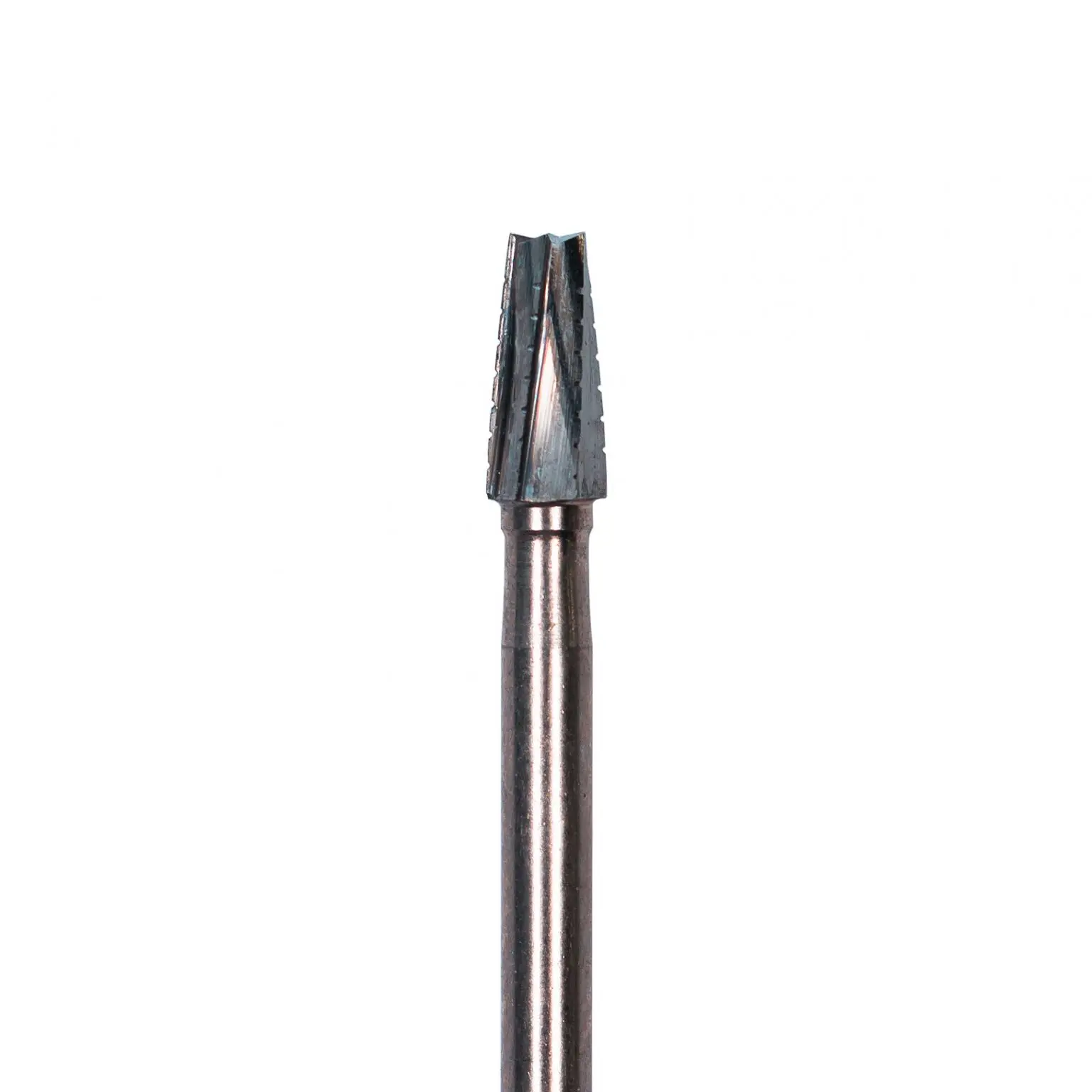Introduction to Dental Burs
Dental burs are indispensable tools in modern dentistry, playing a critical role in various dental procedures. These rotary instruments, designed for cutting hard tissues such as enamel or bone, come in diverse shapes, sizes, and materials. The need for precision, efficiency, and patient comfort has driven significant advancements in the design and manufacture of dental burs. As a result, today's dental professionals have access to a wide range of options to suit specific clinical needs. Whether sourced from a wholesale dental bur supplier or directly from a dental bur manufacturer, the choice of bur can greatly impact the success of dental treatments.
Round Dental Burs: Basics and Applications
● Characteristics of Round Burs
Round burs are among the most versatile and commonly used types of dental burs. Their spherical shape allows them to easily access and excavate large areas of decay, making them ideal for the initial stages of cavity preparation. Typically made from tungsten carbide or diamond, these burs are known for their durability and cutting efficiency. Their design includes multiple blades or diamond grit, which facilitate smooth, controlled cutting.
● Uses in Cavity Removal and Tooth Preparation
The primary use of round burs is in the removal of carious dentin during cavity preparation. They are particularly effective in accessing deep carious lesions and creating rounded internal angles in restorations, which help in stress distribution. Additionally, round burs are used to create retention features in cavity preparations, enhancing the stability of restorative materials. Dentists often rely on these burs for their ability to remove decay quickly while minimizing damage to healthy tooth structure.
Pear-Shaped Burs: Design and Functionality
● Unique Shape and Advantages
Pear-shaped burs are characterized by their tapered, bulbous design, which resembles a pear. This shape allows for the efficient creation of undercuts and the preparation of cavity walls with a slight occlusal convergence. The design of pear-shaped burs facilitates controlled removal of tooth structure while allowing for precision placement of restorative materials.
● Applications in Tooth Trimming and Fillings
In restorative dentistry, pear-shaped burs are invaluable for creating undercuts that secure filling materials in place. Their design also makes them ideal for trimming and finishing composite restorations, ensuring a smooth transition between the restoration and natural tooth surface. Dentists prefer pear-shaped burs when precision and control are paramount, such as in the preparation of occlusal surfaces and proximal box forms.
Cylindrical Burs: Precision in Cutting
● Design Features of Cylindrical Burs
Cylindrical burs, with their straight sides and flat ends, are designed for precise cutting and shaping of dental materials. These burs are often available in a variety of diameters and lengths, allowing them to be used in a range of clinical scenarios. Their construction typically involves high-quality materials like tungsten carbide or diamond, which provide excellent cutting capabilities and longevity.
● Role in Cutting and Adjusting Dental Materials
Cylindrical burs are essential for refining cavity walls and adjusting dental materials during restorative procedures. They are particularly useful in the removal of old restorations and for shaping enamel and dentin prior to restorations. The precision offered by cylindrical burs ensures that minimal healthy tooth structure is removed, enhancing the overall integrity of the dental restoration.
Inverted Taper Burs: Creating Inverted Tapers
● Structure and Benefits of Inverted Taper Burs
Inverted taper burs have a distinctive design with a narrow neck and a wider base, which allows for the creation of inverted taper shapes in tooth preparations. This unique structure enhances the bur's ability to produce a dovetail effect, providing mechanical retention for restorative materials.
● Use in Fixation of Filling Materials
Dentists often use inverted taper burs to create slots and grooves that increase the retention of fillings. The design of these burs enables the creation of retentive cavity forms that help in securely holding restorative materials. Additionally, they are suitable for flattening pulpal floors and creating precise internal angles, contributing to the long-term success of dental restorations.
Tapered Burs: Detailed Tooth Preparation
● Design for Precision and Control
Tapered burs feature a gradually narrowing design that provides excellent control and precision during tooth preparation. These burs are available in various taper angles, allowing dentists to select the appropriate bur for specific clinical requirements. The precision offered by tapered burs makes them ideal for procedures that require meticulous attention to detail.
● Applications in Detailed Tooth Finishing
Tapered burs are commonly used in crown and bridge preparations, where precise shaping of tooth structure is critical. Their design aids in refining margins and creating smooth, beveled edges, essential for proper seating and fit of restorations. Additionally, tapered burs are used for finishing and contouring composite resin restorations, ensuring a seamless integration with the surrounding tooth structure.
Materials Used in Dental Burs
● Common Materials for Manufacturing Burs
Dental burs are manufactured using a variety of materials, each offering distinct advantages. The most common materials include tungsten carbide, stainless steel, and diamond. Tungsten carbide burs are renowned for their hardness and sharp cutting edges, making them ideal for high-speed applications. Diamond burs, known for their durability and abrasive properties, are commonly used for grinding hard materials like porcelain. Stainless steel burs, though less hard than carbide or diamond, offer flexibility and are often used in procedures requiring low-speed cutting.
● Impact on Performance and Durability
The choice of material significantly impacts the performance and longevity of dental burs. Tungsten carbide burs, for example, provide a fast, smooth cutting action with minimal vibration, which enhances patient comfort and reduces operator fatigue. Diamond burs, with their abrasive surface, are excellent for precise cutting and finishing. The durability and performance of a bur are crucial considerations for dental professionals, influencing the quality and efficiency of dental procedures.
Selection Criteria for Dental Burs
● Factors Influencing Bur Choice
Selecting the appropriate dental bur involves considering several factors, such as the procedure type, the bur's material, shape, and size, and the patient's specific needs. Dentists must evaluate the hardness of the tissue being cut, the desired speed and efficiency of the procedure, and the level of precision required. Additionally, ergonomic factors such as the bur's grip and weight may influence the choice, as they impact the dentist's comfort and control during use.
● Tailoring Burs to Specific Dental Procedures
By matching the characteristics of a bur to the demands of a specific procedure, dentists can optimize outcomes and enhance patient care. For example, high-speed diamond burs are often chosen for procedures involving hard materials like ceramics, while tungsten carbide burs are preferred for rapid excavation of dentin. Tailoring burs to the clinical scenario ensures that dental professionals achieve the desired results efficiently and effectively.
Advancements in Dental Bur Technology
● Recent Innovations in Dental Burs
The field of dental burs has seen significant technological advancements, with innovations aimed at improving cutting efficiency, reducing patient discomfort, and extending bur longevity. Modern burs are now available with enhanced coatings that increase cutting efficiency and reduce friction. Innovations such as multi-fluted designs and vibration-reducing features have further improved the performance of dental burs.
● Enhanced Performance and Outcomes
Advancements in dental bur technology have led to improved clinical outcomes, with procedures being completed more swiftly and accurately. The integration of modern materials and designs results in burs that cut more efficiently and last longer, providing value for both dentists and patients. These innovations underscore the critical role that dental burs play in the delivery of high-quality dental care.
Conclusion: Choosing the Right Dental Bur
● Summary of Key Points
Choosing the right dental bur is essential for successful dental procedures. The wide variety of burs available, including round, pear-shaped, cylindrical, and tapered designs, allows dentists to tailor their choice to specific clinical needs. Factors such as bur material, shape, and intended use must be carefully considered to ensure optimal performance and patient outcomes. By understanding the unique properties and applications of different dental burs, dental professionals can enhance the precision, efficiency, and comfort of their treatments.
● Importance of Proper Bur Selection for Effective Dentistry
The selection of the appropriate dental bur is a critical component of effective dentistry. By aligning the bur's characteristics with the procedure's requirements, dentists can achieve superior results and enhance patient satisfaction. Whether sourced from a wholesale dental bur supplier or crafted by a specialized dental bur manufacturer, the right bur can make all the difference in achieving successful dental outcomes.
Boyue: A Leader in Dental Bur Manufacturing
Jiaxing Boyue Medical Equipment Co., Ltd, a leader in the field of dental bur manufacturing, employs advanced 5-axis CNC precision grinding technology to produce high-quality rotary cutting tools. Specializing in dental burs, files, and surgical instruments, Boyue stands out with its R&D team, accurate inspection processes, and large production capacity. With a strong emphasis on quality, Boyue delivers competitive prices and exceptional service. As a full-line carbide rotary burs and files manufacturer, Boyue serves the global market, meeting diverse customer needs with a wide variety of head shapes for surgical and laboratory use.

Post time: 2025-03-06 17:44:05


